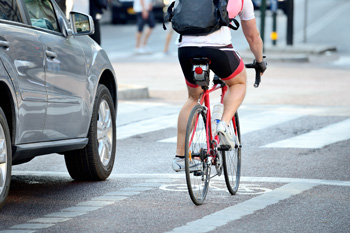Bicycles are considered vehicles, so they have very similar rights as other vehicles. They have the rights to share the roadways and travel in the same way as other vehicles. The issue is that they usually travel at the lower speed than the flow of traffic, and sometimes it is difficult to notice them or predict their next move.

Remember, if you have an accident with a bicyclist causing him/her serious injuries or death, you will face major consequences. Therefore, follow these safety tips to reduce the chances of having a collision with a bicyclist:
- Sometimes it is difficult to notice bicyclists, so always look out for a bicyclist.
- Be very careful, slow down and prepare to stop when you see children on bicycles riding near you. Children are unpredictable and do not know the traffic laws. They can suddenly ride in front of your car.
- Be mindful that bicyclists have limited speed and do not have the same weight and size of your car, so when you see a bicyclist in your lane or near your car, slow down, keep at the safe distance and give him/her the right of way.
- If you need to pass a bicyclist, be patient and only pass when the situation is safe and allow at least four feet of space between your vehicle and the bicyclist when passing.
- Do not drive in the bike lane unless you will be turning within 200 ft.
- Look for approaching bicyclists before opening your car's doors.
Bicyclists also have responsibilities
Bicycles are considered vehicles, so bicyclists have the same rights and responsibilities as the other vehicles, and the same traffic laws apply to the bicyclists on the public roads. Remember, just because bicycles are more lightweight than cars and the bicyclists supposed to be given the right of way, it does not give the bicyclists the right to act irresponsibly and put themselves and others at the risk of accidents. Make sure that your bicycle is safe and you have full control of your bicycle when riding on the public roads.
The law requires that:
- Your bike must have a seat and functioning brakes.
- Your bike must have handlebars positioned lower than your shoulders.
- When you are on the bike, your bike should fit you properly. Your foot should easily reach the ground in order for you to be able to stop safely and have control of your bike.
- Protect yourself by wearing a helmet. If you are on a bicycle and get into an accident and do not have a helmet, the injury can be fatal if you hit your head, so be safe and wear a helmet. California law requires that all bicyclists under the age of 18 wear a helmet.
- Always obey all traffic laws; stop at the stop signs and stop lights. Try not to go through the yellow light because you may not have enough time to make it before it turns red.
- Always ride in the same direction as the traffic.
- Do not ride too close or too far from the curb. If you ride too close to the curb, you may hit the curb and lose control of your bike. If you drive too far to the curb, you will be riding too close to the ongoing traffic and the cars may hit you and cause you a serious injury.
- Keep your eyes on the road and avoid riding over potholes or other road obstacles or hazards.
- Do not drive too close to the parked cars to avoid getting hit by a car door that may suddenly open by a driver or passenger.
- Always use hand signals when making turns or changing lanes:
- To signal left, extend your left arm out (look behind and over your left shoulder before making a left turn).
- To signal right, extend your left arm out with your elbow bent up.
- To signal stop, extend your left arm down.
- Make sure other vehicles can see you, especially at night. When riding your bike at night, the law requires that your bike has:
- A front light that is visible from a distance of at least 300 feet.
- A rear red reflector that is visible from a distance of at least 500 feet.
- A white or yellow reflector on each pedal or the bicyclist's shoes or ankles visible from a distance of at least 200 feet.
- Watch out for vehicles that may not obey the traffic law or may not notice you. Be prepared to stop or react in a safe manner to a traffic situation.
- Watch out for vehicles that may suddenly pull out in front of you and be prepared to stop.
- Watch out for drivers that pass you and are trying to make a right turn afterward and be prepared to stop.
- Be very careful at the intersections – watch out for the oncoming drivers who are trying to make a left turn.
